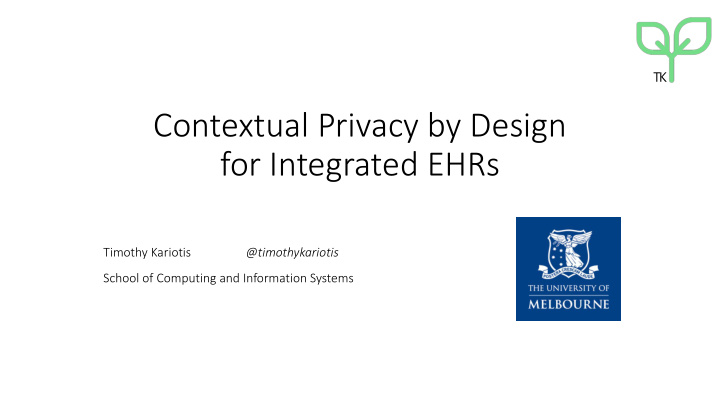



TK Contextual Privacy by Design for Integrated EHRs Timothy Kariotis @timothykariotis School of Computing and Information Systems
Team TK Assistant Professor Darakhshan Mir Associate Professor Shanton Chang Department of Computer Science School of Computing and Information Systems Associate Professor Kathleen Gray Health and Biomedical Informatics Centre Dr Megan Prictor Melbourne Law School
Once upon a time... TK A researcher was designing an electronic health record. Being a responsible researcher they decided to undertake a contextual integrity evaluation before implementing this EHR. The research found that the EHR looks to be breaching contextual integrity. However, they thought this breach was justified, due to the EHR upholding the values and ends of the healthcare context. So the technology was implemented...BUT THEN...
TK TO BE CONTINUED
Evaluative → Design TK How do we take the evaluative/analytical power of contextual integrity and apply it in the design space?
Context of Work TK • A fragmented health system • Healthcare • Mental healthcare • Social care • Informal supports • Poor information sharing • Electronic Health Record solution
Contextual Integrity of EHR TK • Transmission principles • Push to Pull • Event-based • Context-aware (?) • Justified • Benefits to patient and clinician Kariotis, T., Prictor, M., Chang, S., & Gray, K. (2019). Evaluating the Contextual Integrity of Australia's My Health Record. Studies in health technology and informatics , 265 , 213- 218. doi: 10.3233/SHTI190166
Privacy by Design TK Pro-active consideration of privacy in both the technical and governance of information technologies. Cavoukian, A. (2009). Privacy by Design in Law, Policy and Practice. Retrieved from http://www.ontla.on.ca/library/repository/mon/25008/312239.pdf
Contextual Integrity TK • Appropriate flow of information 1. Information flow 2. Prevailing Context • Context-specific information 3. Actors norms 4. Transmission Principles • Does a new technology breach 5. Entrenched Information norms vs designed-in-norms these norms? 6. Initial Assessment – Prima Facie breach... 7. Evaluation I: Key Interests 8. Evaluation II: Moral and Political Interests 9. Evaluation III: Contextual values, goals, ends 10. Outcome Nissenbaum, H. (2009). Privacy in context: Technology, policy, and the integrity of social life . Stanford University Press.
TK How can we take the evaluative power of contextual integrity and use it to consider the design of new technologies?
Appropriation of Technology TK • Technology is shaped by social/organisational context • Social/organisational context shaped by technology “Technology is never purely technological; it is also social. The social is never purely social; it is also technical. This is something easy to say but difficult to work with.” J. Law, and W. Bijker, Postscript: Technology, Stability, and Social Theory, in: Shaping Technology / Building Society, The MIT Press, London, UK, 1992. (p305).
Adaptive Structuration Theory TK • Technology has.... Structural Features Spirit G. DeSanctis, and M.S. Poole, Capturing the complexity in advanced technology use: Adaptive structuration theory, Organization Science. 5 (1994) 121 – 147.
Adaptive Structuration Theory TK • Technology has.... Appropriation Moves Structural Features Spirit Faithfulness Org structure
Adaptive Structuration Theory TK Context Emergent-norms Norms Context-of-Design Designed-in- ”norms”
Context-of-Design TK • Designers bring together a number of stakeholder values/ends/goals/norms • Interpretation of the context A. Albrechtslund, Ethics and technology design, Ethics and Information Technology. 9 (2007) 63 – 72. doi:10.1007/s10676-006-9129-8.
Context TK • What do we actual mean by context? • Context-as-symbolised • Context-as-experienced • Context-as-framed • Context-as-designed • Context-through-appropriation R.M. Dilley, The problem of context in social and cultural anthropology, Language & Communication. 22 (2002) 437 – 456. P. Dourish, What We Talk About when We Talk About Context, Personal Ubiquitous Comput. 8 (2004) 19 – 30. doi:10.1007/s00779-003-0253-8.
Context TK “Contexts are sets of connections construed as relevant to someone, to something, or to a particular problem, and this process yields an explanation, a sense, an interpretation for the object so connected.” R.M. Dilley, The problem of context in social and cultural anthropology, Language & Communication. 22 (2002) 437 – 456.
Designed-In Norms TK • Through structural features and spirit, technology has ‘designed -in- norms.’ • Not actual norms – but inscribed norms or rules...
Linking Context and Tech TK Values Values Goals & Goals & Ends Ends Norms Norms Processes Design Technical Specifications Forms and artefacts Social Technical I. van de Poel, Translating Values into Design Requirements, in: D.P. Michelfelder, N. McCarthy, and D.E. Goldberg (Eds.), Philosophy and Engineering: Reflections on Practice, Principles and Process, Springer Netherlands, Dordrecht, 2013: pp. 253 – 266. doi:10.1007/978-94-007-7762-0_20.
Linking Context and Tech TK Values Values Goals & Spirit Ends Designed-in- Norms norms Structural Features Processes Technical Specifications Forms and artefacts Social Technical I. van de Poel, Translating Values into Design Requirements, in: D.P. Michelfelder, N. McCarthy, and D.E. Goldberg (Eds.), Philosophy and Engineering: Reflections on Practice, Principles and Process, Springer Netherlands, Dordrecht, 2013: pp. 253 – 266. doi:10.1007/978-94-007-7762-0_20.
Method for Contextual PbD TK • Participatory Design • Co-Design • Living Labs • LIVED EXPERIENCE • Design-in-use D. J. Mir, Y. Shvartzshnaider, and M. Latonero, “It Takes a Village: A Community C. A. Le Dantec, E. S. Poole, and S. P. Wyche, “Values as lived experience: evolving value Based Participatory Framework for Privacy Design,” in 2018 IEEE European sensitive design in support of value discovery,” presented at the Proceedings of the SIGCHI Symposium on Security and Privacy Workshops (EuroS&PW) , 2018, pp. 112 – 115. conference on human factors in computing systems, 2009, pp. 1141 – 1150.
Participation TK “Participation is a transformative concept. It is a way of life, a way of seeing the world and a way of being in the world.” M. Ledwith and J Springett, Participatory practice: Community-based action for transformative change . Policy Press, 2010. “The oppressed, having internalized the image of the oppressor and adopted his guidelines, are fearful of freedom.” P. Freire, “Pedagogy of the oppressed (revised),” New York: Continuum , 1996.
Let’s continue the conversation TK Timothy.Kariotis@unimelb.edu.au @timothykariotis www.linkedin.com/in/timothy-kariotis/ Also...if you want to work on, - Actor-Network theory + context - Participation and norms - Appropriation theory Let me know!
Recommend
More recommend